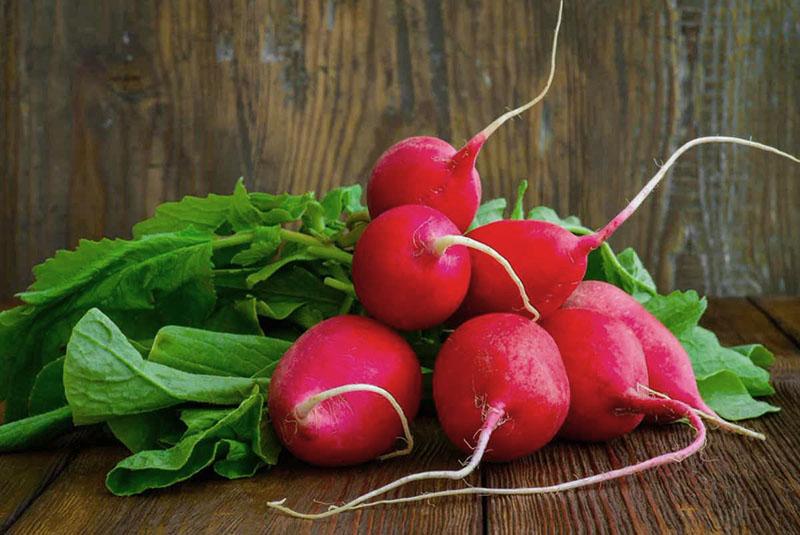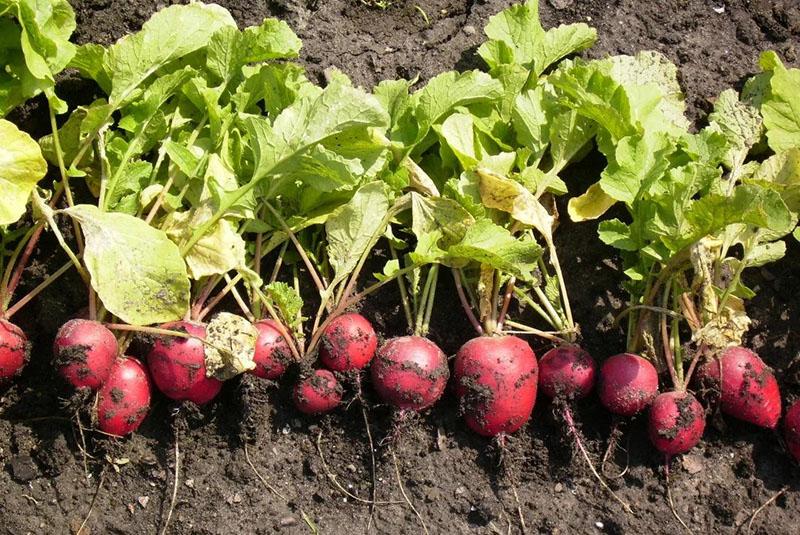Why is radish growing bitter or going into the tops
 One of the most common problems that many gardeners face when growing radishes is the unpleasant bitterness of root crops. There are several reasons why radishes are bitter, and there are several ways to remove an unpleasant pungent taste.
One of the most common problems that many gardeners face when growing radishes is the unpleasant bitterness of root crops. There are several reasons why radishes are bitter, and there are several ways to remove an unpleasant pungent taste.
Why is radish bitter - the main reasons

The most common factors include:
- Improper Watering - Radish roots contain moderately concentrated mustard oil, giving them their characteristic flavor. When there is a lack of moisture, the oil level rises, which gives the radish bitterness.
- Late harvest - overripe roots become too bitter and practically unusable.

- Lack of space - crowdedness can be one of the reasons why radishes are not tied.
The reason for problems when growing radishes can be the lack of regular loosening and weeding, as well as improper organization of lighting of the vegetable crop.
Good harvest rules
 Radish is a rather "capricious" culture. To obtain a rich harvest of root crops with a pleasant sweet taste and a barely noticeable bitterness, you need to provide the radishes with regular and high-quality care. It consists of several important points - the organization of proper lighting, systematic watering, loosening and weeding of the beds.
Radish is a rather "capricious" culture. To obtain a rich harvest of root crops with a pleasant sweet taste and a barely noticeable bitterness, you need to provide the radishes with regular and high-quality care. It consists of several important points - the organization of proper lighting, systematic watering, loosening and weeding of the beds.
Lighting for radish
 There are many reasons why radishes grow into their tops and taste bitter when ripe. And one of the main ones is incorrect lighting. Radish does not like long daylight hours, it should be under light for no more than 8-10 hours.
There are many reasons why radishes grow into their tops and taste bitter when ripe. And one of the main ones is incorrect lighting. Radish does not like long daylight hours, it should be under light for no more than 8-10 hours.
For radishes, both excess and lack of sunlight are dangerous. With excessive light, the roots begin to age quickly and become bitter. In such cases, the plantings must be covered with an opaque material. When covering beds with radishes, care must be taken to ensure that oxygen remains freely available to them.
 Too shaded places are no less dangerous - when grown in the shade, the growth of tops accelerates, and the roots remain small.
Too shaded places are no less dangerous - when grown in the shade, the growth of tops accelerates, and the roots remain small.
The best option would be to find the culture in the sun until 4-6 pm, after which it is hidden under a dark film or burlap.
Proper watering
 Among the common reasons why in a greenhouse, radishes have gone to the tops or root crops have a sharp, bitter aftertaste - improper watering. Radish belongs to moisture-loving crops that require regular and abundant watering.
Among the common reasons why in a greenhouse, radishes have gone to the tops or root crops have a sharp, bitter aftertaste - improper watering. Radish belongs to moisture-loving crops that require regular and abundant watering.
Basic rules for watering edisa:
- radishes should be abundantly moistened at all stages of growth - from sowing to harvesting root crops;
- watering should be deep, the soil should be moistened up to 20-30 cm deep;
- in order for the soil to be sufficiently moistened, watering is best done in stages;
- for watering 1 sq. m. beds with radishes will require 12-15 liters of water;
- the best option is watering by sprinkling - it does not erode the soil and does not injure the roots;
- for irrigation, only pre-settled water at room temperature is used.
The frequency of watering your radishes depends on the weather conditions. On hot summer days, the beds should be watered in the early morning and evening, daily.Watering during the day is of no benefit, as moisture quickly evaporates through the leaf cells.
In cool weather, water the radishes every 3-4 days.
Thinning radish
 Radish seeds are very small, so it is difficult to sow them at a sufficient distance. Too thick and frequent sowing negatively affects the size and taste of the fruit, therefore, in such cases, the beds are thinned. Tightness is one of the reasons why radishes are bitter. If too crowded, roots grow weak, lethargic, lacking moisture and nutrients.
Radish seeds are very small, so it is difficult to sow them at a sufficient distance. Too thick and frequent sowing negatively affects the size and taste of the fruit, therefore, in such cases, the beds are thinned. Tightness is one of the reasons why radishes are bitter. If too crowded, roots grow weak, lethargic, lacking moisture and nutrients.
Thinning of radishes is carried out taking into account several rules:
- 6-7 days after the appearance of the first shoots, weak seedlings should be removed, leaving a distance between the seedlings of about 3-5 cm;
- re-thinning is carried out after 4 weeks - all weak shoots are removed, there should be a distance of 1-2 cm between the remaining plants;
- the last thinning should be done after the first root crops have ripened - they should be selected to allow the remaining plants to mature.
In order not to damage fragile plants, it is advisable to thin them only after preliminary watering of the soil.
The soil around the radish should be lightly supported with your palm so as not to injure the remaining stems. After thinning, the soil in the beds should be loosened and watered well.
Loosening and weeding
 Why radishes are bitter depends on the conditions of their cultivation. For full growth and ripening of radishes, you need to regularly weed control in the beds. They draw out nutrients and moisture from the soil - as a result, radishes acquire an unpleasant, bitter taste. Weed control is carried out as soon as they appear.
Why radishes are bitter depends on the conditions of their cultivation. For full growth and ripening of radishes, you need to regularly weed control in the beds. They draw out nutrients and moisture from the soil - as a result, radishes acquire an unpleasant, bitter taste. Weed control is carried out as soon as they appear.
 Loosening of the soil is equally important. The first treatment is carried out before the germination of the first shoots - this improves their germination and stimulates growth. The soil must be loosened after each watering of the plants to a depth of no more than 3-4 cm, so as not to damage the fragile radish roots.
Loosening of the soil is equally important. The first treatment is carried out before the germination of the first shoots - this improves their germination and stimulates growth. The soil must be loosened after each watering of the plants to a depth of no more than 3-4 cm, so as not to damage the fragile radish roots.
Timely harvest
 It is very important not to let the radishes overripe and to harvest them when they are ripe. You should not leave "adult" roots in the soil - they will not grow larger, but will accumulate bitter mustard oil and their taste will be spoiled. When overripe, the radish pulp becomes coarse and fibrous, begins to crack, dries up inside and becomes tasteless.
It is very important not to let the radishes overripe and to harvest them when they are ripe. You should not leave "adult" roots in the soil - they will not grow larger, but will accumulate bitter mustard oil and their taste will be spoiled. When overripe, the radish pulp becomes coarse and fibrous, begins to crack, dries up inside and becomes tasteless.
Most often, the radish ripens unevenly. Many gardeners are in no hurry to collect ripened root crops, leaving them until the rest of the plants ripen. This cannot be done; in order to avoid their bitterness and lethargy, it is better to harvest the crop in stages.
How to remove bitterness
 The bitterness in the taste of radish is not a reason to throw away the grown crop.
The bitterness in the taste of radish is not a reason to throw away the grown crop.
There are simple and affordable ways to remove bitterness from radishes and make them usable:
- Soaking in saline solution - to prepare it, you need to dilute 1 teaspoon of salt in 1 liter of water. Rinse the radishes, remove the tops, and pour the root vegetables with saline for 35-40 minutes.

- The washed root vegetables without tops should be cut into halves or pieces, sprinkled with salt and left to infuse for 15 minutes, then rinsed under running water. The salt quickly reduces or completely removes the bitterness from the radish.
- The radishes must be washed and cut in half. After that, pour the root vegetables with boiling water and leave for 8-10 minutes, then use for preparing salads and other dishes.
 Boiling radishes is considered the least preferred. Hot water "draws" not only bitterness out of root crops, but also a significant part of nutrients. Also, if you keep the radish in boiling water for too long, it can become lethargic and tasteless.
Boiling radishes is considered the least preferred. Hot water "draws" not only bitterness out of root crops, but also a significant part of nutrients. Also, if you keep the radish in boiling water for too long, it can become lethargic and tasteless.
There are several answers to the question of why the radish is bitter and how to fix this unpleasant situation. The reason is non-compliance with the basic agrotechnical recommendations for growing radish.The right choice of a place for sowing, regular watering, thinning and weeding of the beds will help you get a rich harvest of juicy and crunchy root crops with a pleasant, delicate taste.